Plum Tree Guide — all you need to know AD-FREE!
The Plum tree was domesticated by humans LONG ago. Its found in Neolithic age archaeological sites. Plum trees are grown for food, or to stop erosion. Grow them as a fence line or as an ornamental tree (for its ornamental flowers). Finally, wildlife and pollinators thrive on Plum trees. Grow the tree for food, fence, ornamentally or for wildlife! This Guide will show YOU how.
Plum Tree Guide on ONE webpage!

On this page:
1. Plum Tree Fact Sheet.
2. Types of Plum Tree.
3. Plum trees used in landscaping and urban gardens.
4. Harvest and eat plums (fresh, compote, jam, fruit roll or dried, umeboshi, etc.) and the plum’s medicinal qualities.
5. Commercial viability.
6. Plum Tree Guide for Care and Maintenance.
7. Propagating the Plum tree.
8. Plum trees we grow organically. HEPPY girls!
Plum trees native to North America became a special interest. There are SO many varieties. We grow five varieties of wild Plum trees here at HEPPY™.
________________________________________
see our list of 400 edible plants
YouTube channel (please subscribe)
Plum Tree Fact Sheet:
Use in garden design, permaculture, and organic gardening
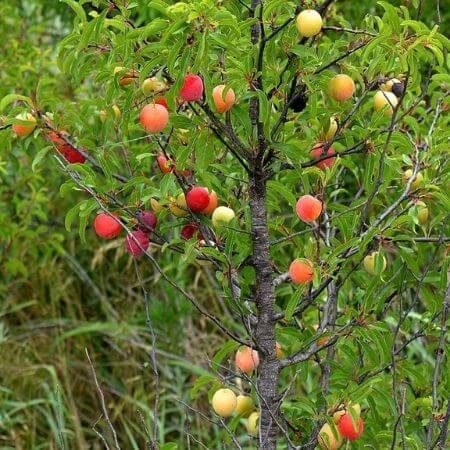

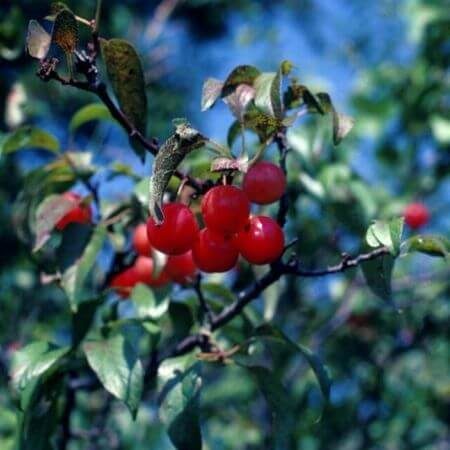


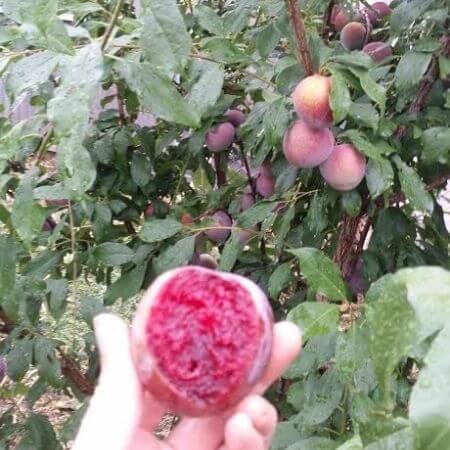
picture credits (until we get our own ;). in order of appearance:
1. Chickasaw Plum, Prunus angustifolia – possibly by Ted Lee Eubanks’ Fermata via Pintrest.
2. American Plum, Prunus americana – by garden.org.
3. Creek Plum, Prunus rivularis – by aggie-horticulture.tamu.edu.
4. Methley Plum, Prunus salicina – by mygardenlife.com.
5. Mexican Plum, Prunus mexicana – by minnetonkaorchards.com.
6. Satsuma Plum, Prunus salicina – by edibleadelaide.com.
Fact Sheet
Zone: 5 to 9 (individual cultivars vary)
Height: 15 to 30 feet (cultivars vary, usually below 20’)
Native: North America
Bloom Time: April – May
Bloom Color: white
Fruit Maturity: June – Sept. (depending on zone and variety)
Self-fertile: yes & no (see Plum Tree Pollination below)
Sun: full sun to full shade (high variation; native can grow with little sun; fruiting species or, max fruit production requires full sun)
Water: medium (will tolerate drought)
Soil: forgiving (well draining is optimal)
Maintenance: low
Growth Rate: fast
Deciduous or evergreen: deciduous
Edible¹: fruit (more information is below)
Medicinal²: yes (discussed below)
Commercial viability: strong (discussed below)
Family / Genus: Rosaceae / Prunus
Remarks: WIDE variation within native varieties, and between native and cultivar varieties. WIDE range of uses including commercial use, to stop erosion, wildlife food/habitat, as a fence line, etc. healthy Plum trees are disease free. can have remarkable fruit production.
Types of Plum Tree. What’s the difference?
Wild and Cultivar Categories of Plum Tree
the HEPPY™ Plum Tree Guide categorizes trees as wild (native) or cultivar. we are bias towards native plants — emphasizing edible fruiting trees and shrubs that are MOST adaptable and sustainable. so, what’s the difference?
Wild Plum Tree (Native to North America)
wild plum trees produce smaller fruit. sometimes the fruit is sweet and sometimes tart within the SAME species. however, these trees are more adaptive, hardy and functional than cultivars.
the wild plum tree is supremely adapted to grow in wide variety of environments. they are most forgiving, and most disease resistant. use them to prevent erosion, or build a fence line. grow them as an upright tree or as a bush. also, wild plum trees provides fruit that can be sold at a premium. (native to France is the Briançon Plum [Prunus brigantina]. also called the Marmot Plum or Alpine Plum. native plum trees are regional specialists.)
consequently, the wild plum tree can provide fruit and a fence. it can provide wildlife food and mitigate erosion. it can be grown upright or as a bush. it’s supremely low maintenance and adaptable. so, it’s a HEPPY plant!
click here to see ~all 15 wild plum trees growing in North America. view size, function (fence, food), plum fruit color and fruit texture, and more!
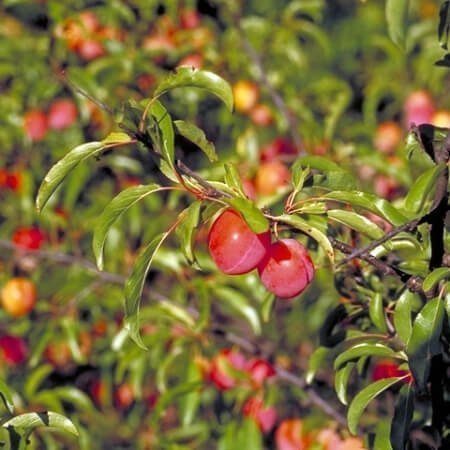
Cultivar Plum Tree
“cultivars” are domesticated plants. just like animals were domesticated, plants were selected for specific qualities. plum tree cultivars produce predictable crops of larger fruits. also, the plum fruit are usually sweeter.
the European Plum Tree (Prunus domestica) and Japanese Plum Tree (Prunus salicina) produce most cultivars. and, they produce the plum fruit you find in grocery stores.
European Plum varieties include: Blue Rock, Blue Tit, Czar, Damsons, French, Green Gage, Imperial, Italian, Jefferson, Laxton’s Delight, Mallard, Mirabelles, Opal, Oullins Gage, Pershore, President, and Victoria.
Japanese Plum varieties include: Autumn Rosa, Beauty, Elephant Heart, Friar, Golden Nectar, Howard Wonder, Kelsey, Mariposa, Nubiana, Santa Rosa, Satsuma, and Wickson.
Plum Tree Guide for Landscaping and Garden Ideas
HEPPY™ grows the wild North American (NA) plum tree and select Asian plum trees. at HEPPY, plum trees are grown in a variety of locations to show their versatility. some are grown along a stream bank, as an understory tree, and along our driveway (for the plum tree’s ornamental quality). all are grown for food.
Landscape Architecture
in landscape architecture, plums trees fit any landscape. they require less care than peaches, nectarines and apricots.
the best suited sites are areas were fruit fall will not occur by foot traffic and driveways.
the NA wild Mexican Plum tree and Chickasaw Plum tree are ideal single accent tree. cultivars are also ideal single accent trees.
the American, Beach and Creek plum trees are excellent accent bushes if planted in full sun and kept pruned (inducing new leaf growth and blooms).
these NA plum trees sucker. consequently, they can be planted as a hedgerow – a fragrant fence. The latter is best in a more open, rural setting; for a standard residential home, regular pruning would be required.
Garden Ideas
NA wild plum trees are VERY forgiving – they’ll grow in any soil. all NA Plums grow fast, and prefer full sun. most tolerate part shade (Beach Plum least shade-tolerant). the American, Beach, Chickasaw, and Creek plum trees are optimal for erosion control, and all varieties are excellent trees for restoration projects. in fact, the Beach Plum was one of four native plants that were the most successful in NJ and NY landfill, urban wasteland reclamation project.
cultivar plum trees are not as forgiving. plant them were there’s good air circulations and water drainage. plant cultivar plum trees on top of a mound of well-draining soil.
cultivars are susceptible to brown rot disease. HOWEVER, a sunny location with air circulation and well draining soil is likely to prevent all issues.
NA plum trees self-pollinate. their fruit vary in size (1/4″ to 1+”) and colors include hues of red, orange, yellow, blue, or purple.
cultivar plums trees do NOT self-pollinate (rare exceptions). their fruit vary in size (3/4″ to 2 1/2″) and colors range from green to black. the green plum is sweet too, btw. more about pollination is below.
plum tress have one seed; some seeds are as small as a sunflower seed.
i’ve read that the American and Chickasaw plums have thorns. however, I see no growth that qualifies as a “thorn.”
Plum Tree Fruit — How Plums are Eaten and Used Medicinally
1, 2 HEPPY cannot take any responsibility for any adverse effects from the use of plants. Always seek advice from a professional before using a plant for food or medicinally. This information is intended for educational purposes only and should not be considered as a recommendation or an endorsement of any particular medical or health treatment.
Edible Plum Fruit
Plum tree fruit is eaten a million different ways. they’re eaten fresh off a tree, dried, baked, stewed (compote), jammed/jellied, salted, canned, preserved, etc.
North American (NA) native plums are smaller and have mixed reviews. for example, an American Plum tree can bear sweet-leaning fruit while another American Plum tree bears tart-leaning fruit. hopefully our American, Beach, Chickasaw, Creek, and Mexican plum trees bears fruit on the sweet-side.
generally, the American and Mexican Plum trees produce the largest fruit. it’s about 1″. below is a detailed overview of each type of Plum tree — including fruit size. Wild plum fruit vary in size and colors. Colors include yellow, red, rosa, and purple.
cultivar plums are SO varied but there’s MANY varieties that reliably sweet juicy fruit. easy peasy. there are varieties for special uses (specifically to dry to make prunes), or to make umeboshi (sort of a apricot-plum tree fruit for a Japanese dish). fruit skin & flesh are purple, red, maroon, blue, yellow, and green (a green plum that’s sweet!).
European Plum fruit lean towards having firmer flesh, and a shape that’s more oval than round.
Japanese Plum fruit lean towards being juicier, and with a very round shape.
Plum Recipes
Plum fruit can be pickled, caramelized, dried, baked, used as a sauce, stewed (compote), jammed/jellied, in salads, used in dumplings, salted, canned, preserved, etc.
Michigan State University Extension has Plum Jelly recipe.
otherwise, the Net is LOADED with recipes BUT websites (2021) have gone overboard with ads. it’s hard to find content within the ads.
volunteer at HEPPY™ to write ad-free webpages for plum fruit recipes!!
Plum Tree and Plum Fruit's Medicinal Uses and Medicinal Qualities
at least 19 American Indian tribes use/used the American Plum Tree for food and medicine (Native American Ethnobotany).
examples of how the American Plum tree was used include, as a cough medicine, and kidney and urinary aid (Cherokee); an oral aid (Cheyenne); and as a disinfectant and dermatological aid (Chippewa).
“A Systematic Review on the Health Effects of Plums (Prunus domestica and Prunus salicina)” found that “plum continue to show promising results on its anti-inflammatory, antioxidant and memory-improving characteristics.”
of course, as with virtually all edible fruits i research i find this blurb: “Evidence on the health effect of plums has not been extensively studied, and the available evidence needs further confirmation.” well, da. the plum tree has been domesticated by humans for thousands of years — of course it remains a mystery to health sciences!
Commercial Viability of the Plum Tree and Plum Fruit
the commercial viability is strong. the plum is IDEAL as a farmer’s market and food cottage product. it’s a specialty food, processed and jarred or canned, or sold fresh. as a low-maintenance tree, the Native Plum Tree is particularly useful. cultivars have purpose as a heavy fruiting tree or ornamental tree.
Plum Fruit in the Farmers' Market or Cottage Food Industry
fresh fruit, jams, jellies, preserves, baked good — the list goes on. it can be a specialty food — dried, or made into a fruit roll. pick-your-own farm is another larger scale opportunity.
fresh plum fruit have a good shelf-life. keep them dry after picking. slightly unripe fruit will ripen in 2 to 3 days at room temperature. refrigerate ONLY if ripe. place in a plastic bag and refrigerate. ripe plums will last 3 to 5 days in the fridge.
compote is what ‘old school’ Germans made. it’s a process similar to canning or jarring plum tree fruit. except, we froze the compote. plum compote will last at least 12 months in the freezer.
making compote is easy. fruit is cooked until it breaks down, and a little sugar is added. add cinnamon too. this is a food preservation technique that works for plum, apricot, nectarine, peach and, about any fruit.
dry plum fruit rolls takes more time. it requires blending the fruit (like, in a food processor) and baking the subsequent puree. dry plum fruit rolls store in a fridge or freezer. this is a food preservation technique that works for plum, apricot, nectarine, peach, and many other fruits.
umeboshi is a Japanese dish. it’s made from a ‘plum’ that is more closely related to an apricot. but the technique works for any plum. it’s a way to pickle, salt or create a sweet, semi-dry plum as a side-dish. umeboshi illuminates the variety of ways the wonderful plum fruit can be prepared and eaten!
Plum Tree in Commercial or Private Landscaping
it’s an ideal and adaptive tree. except for NOT planting along sidewalks and driveways (due to fruit fall), the tree has many qualities.
native plum tree varieties provide a hedge or erosion control while supporting wildlife. as a single accent tree that starts a conversation, the Mexican and Chickasaw Plum Trees will do that. upright trees with nicely shaped crowns that provide small fruit (ie, not impeding mowing).
in fact, the Mexican and Chickasaw Plum Trees are hard to find. this market-scarcity increases its price.
cultivars are SO diverse. how about selling SWEET GREEN or sweet bright yellow plums? how’s that for an eye catcher. plum trees are functional and prolific bloomers. they are also an attractive accent tree.
There’s a lot to explore and we invite interns and volunteers to focus on the commercial viability of the Pawpaw here at HEPPY.
Plum Tree Guide to Care and Maintenance:
growing, pruning and harvesting
Know your Plum Tree Species
are you growing and pruning a native plum tree or cultivar? are you growing the plum tree as a hedge or erosion control, or as a accent tree? they are versatile. know and study your Plum tree species 😉
Plum Tree Care
Plum trees are adaptable and versatile. however, the native species more adaptable and versatile than cultivars.
optimal growing conditions are: well-drained soils with organic matter, and full sun. medium amount of water (watering is SO dependent on location).
Soil
soil with organic material encourages stronger / faster growth.
native Plum tree species grow in about any soil. high clay (all natives) or salty’ish beach sand (Beach Plum). HEPPY™ uses super high organic material. our Mexican Plum literally overgrew — branches and foliage was so vigorous that the young tree-trunk couldn’t support the growth! I found her slumped over. (solution: prune off 50% of the growth, and properly stake the tree.)
cultivars will not thrive in high-clay soil. root rot is likely. too much clay promotes root rot. sandy soil lacks organic matter.
Sun
Plum tree will grow well in part shade. the tree’s vigor, flowering (and fruit) MAY decrease. there’s a ‘trade off’. a Plum tree needs full sun for ~at least~ 5 hours (March-October). our Plum trees grow in part shade and do fine.
Disease and Pests
Brown rot (Monilinia fructicola) is the most common fungal disease. it affect the blossoms and fruit of almonds, apricots, cherries, peaches and plums.
REMOVE & DISPOSE OF diseased fruit, cankered branches. bag-it and trash it. that includes the area around the Plum tree.
USE a fungicide. we purchased myclobutanil (Spectracide Immunox Multi Purpose Fungicide Spray). we plan on using it on our Mayhaw and, plums if need-be.
Apply fungicide early. just as bloom-buds appear (ie, flowers have not yet opened). apply before harvest. you may need to apply more often depending on humidity, rain, location, the plant’s inherent resistance, near-by disease, etc. Texas A&M AgriLife Extension Service has this 2-page pdf blurb on Brown rot (Monilinia fructicola) control for “stone fruits” (like, Plum).
other potential fungal disease problems include leaf spot (we live with it), canker (prune/destroy) and black knot (prune/destroy).
Plum curculio is a potential pest. other potential insect problems include aphids, scale, borers and tent caterpillars.
Plum Tree Pollination
generally, native plums ARE self-fertile and cultivars are NOT self-fertile. also, cultivars must be pollinated by the same variety. for example, two varieties of Japanese plums can cross-pollinate, but Japanese plums cannot cross-pollinate with European or Native varieties.
i’ve not studied a native plum tree that’s not self-fertile.
cultivar plum trees that self-pollinate are the Autumn Rosa, Burgundy and French.
Pruning the Plum Tree
pruning is about shape, air circulation, maximizing sun penetration, and disease-control.
Plum tree shape?: do you want a hedge, bush & sprawl or, prune to have a fruiting or accent tree? ALWAYS prune diseased or damaged branches.
if the hedge, bush & sprawl garden design is desired then prune diseased limbs. prune to hedge. fruits will grow on the sun-exposed side of the Plum tree.
if growing for a fruiting or accent tree, then prune to keep branching in portion to the trunk (create a crown). prune at a branch-location where the bud is “pointing” away from the center of the tree.
prune all branches growing through the center of the tree. prune all branches crossing each other. remove suckers, and branches growing from the trunk.
Propagating the Plum Tree:
cuttings, division, grafting, layering and seeding
Propagating Plum Trees
propagate Plum tree by seed, sucker or grafting. buying established plum trees is an easy option for this commonly grown tree.
Growing trees from Seed
native plum trees grow easily from seed. the American Plum grows vigorously from seed. any Plum seed that grows can be grafted on; NOT all Plum tree seeds produce a fruiting tree.
chill (“stratify”) seeds by removing the fruit flesh and stratifying seeds over-winter. in warmer climates, ONE technique is to place seeds in a moist medium (moist paper towel, moist sand or moist peat moss). place in a ziplock bag and refrigerate (36 and 41°F). NEVER freeze seeds. stratify seeds for 1.5 to 5 months. in cooler climates like zone 7, the ANOTHER technique is to plant seeds in soil (fall/winter). plant early before the soil freezes. this is natural stratification. if planting seeds in pots, then keep the soil from freezing. we bury pots into a bed of woodchips.
Growing trees by Division
this is sorta by “division”: harvest the suckers! most native Plum trees sucker, which provides opportunity to gather root stock with a growing trunk (skinny trunk or otherwise, it has roots!). i read and can verify that the Mexican Plum tree does NOT sucker. however, the other native Plum trees do.
in general, cultivars will not sucker.
Grafting trees
how about grafting 175 varieties of plum onto one tree?!?!?! what a Mom Plum Tree (and grafter dude)!
grafting plum trees SUCH an option! there’s so many choices. play it safe and graft within species (scion from a Prunus salicina [Japanese Plum] onto another Prunus salicina).
grafting across species is tricky. here is an INCREDIBLY well cited Chart Outlining The Compatibility Of Plum Tree Scionwood & Rootstock. also, reading the information on this post will answer virtually any question you have about grafting across species of plum trees. (yes, you’re welcome 😉
Propagation Protocol: Prunus
further research can be performed here. fine-tune your search for a specific Prunus species.

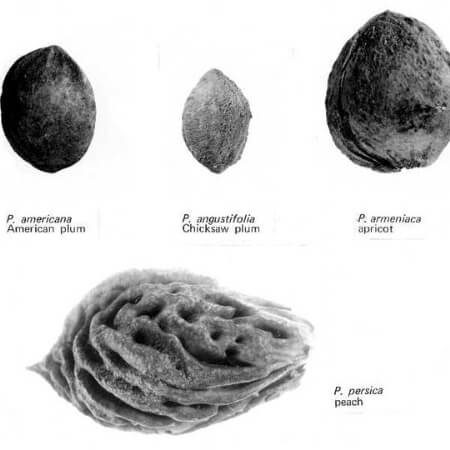

Plum Trees We Are Growing at HEPPY™
follow our trees over time. we purchased five Plum tree varieties between 2016 and 2020.
HEPPY™ grows native plum trees because they require the least maintenance and “fit in” with the environment. we also introduced Japanese Plum tree varieties.
Plum Trees We're Growing in Zone 7
as of March 2021 we have planted these beautiful Plum trees.
1. American, Prunus Americana
2. Beach Plum, Prunus maritima
3. Chickasaw, Prunus angustifolia
4. Mexican, Prunus mexicana
5. Methley, Prunus salicina
6. Satsuma, Prunus salicina
a European specialty Plum tree, Green Gage is being evaluated :/
our American and Mexican Plum trees were purchased in 2016 from Missouri Wildflowers Nursery. Just little ‘sticks’, they’re now 7 feet tall in 2020. (BTW, i recommend not buying small tress as i did; pay a little more and get fruiting-sized trees ;).
they grow in part-shade location. the American plum tree’s branches sprawl. she’s incorrigible 😉 long new growth develops from the roots, trunk and branches.
the Mexican Plum is completely erect. we pruned her to grow with a crown that in proportion to the trunk. very vigorous.
the Chickasaw, Methley and Satsuma were purchased from Willis Orchard in 2020 (on YouTube 😉. i purchased their largest trees and picked them up by car. they are already h.u.g.e. we planted them in spring 2021!!
i have charts and grafts of the best producers, seed ratios, and more. i’d like to have all this posted online. volunteer at, or donate to HEPPY to move this project along!
References
these are the primary resources :
Missouri Botanical Garden: Purnus [x]
USDA PLANTS Database: Purnus [x]







